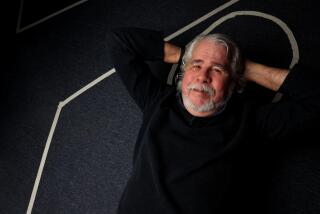‘The Sound and the Fury (April Seventh, 1928)’ at REDCAT
The first section of William Faulkner’s “The Sound and the Fury” is such a notorious brain twister that any attempt at straightforward dramatization would be almost as foolhardy as trying to resurrect the Old South. Told from the point of view of Benjy, the Compsons’ mentally challenged adult son, the narrative hopscotches with such retrospective insouciance that Faulkner was tempted to color-code passages to clarify shifts in time.
Fortunately, Elevator Repair Service, an experimental New York theater company with a daft streak a mile wide, wouldn’t dream of putting Faulkner’s formidable classic into a “Masterpiece Theatre” Cuisinart. In “The Sound and the Fury (April Seventh, 1928),” which concludes its short run this weekend at REDCAT, the group creates a space in which to swirl around in Faulkner’s elegiac prose while Benjy’s doomed family and persevering servants rise up like figures in a collective literary hallucination.
Faithful not just to the novel’s words but to its slippery structure, this ambitious, wacky and erratic piece is reverent to its source material, though not slavishly so. E.R.S.’s madcap sensibility, which no one in his or her right mind would call Faulknerian, is hardly banished. Rather, a détente has been reached between an emotionally full Southern modernist and a performance group whose signature piece might be “Language Instruction,” its 1993 “avant-garde, post-modern, dadaist, deconstructivist comedy” about the boundary-breaking comedian Andy Kaufman.
How much you’ll get out of this sorrowful saga of a genteel Mississippi clan fallen into decadence and disrepair will depend on your willingness to bundle Faulkner fragments. The fluid, role-swapping treatment, blind to both gender and race, isn’t easy to follow, but happily it’s not sink or swim: Information about the characters, along with short excerpts from the book, are projected onto the back wall of David Zinn’s cozy re-creation of the Compsons’ gracious homestead.
A stickier problem, at least for me, has to do with how readily one accepts an aesthetic that combines impressive discipline (Mark Barton’s lighting is especially first rate) with a casualness that occasionally seems like sloppiness. For E.R.S., consistency is clearly the hobgoblin of little minds, but the way the company introduces and then abandons performance elements leaves an impression of half-baked informality.
For example, as we follow the story of Benjy and his siblings, neglected by their damaged parents and tended to by an overburdened black maid and her children, there are frenetic outbursts of country-and-western dancing. But then the hyperactive choreography unexpectedly vanishes from the piece, just as melodramatic music is suddenly boomed in as though from another play.
E.R.S. has often been compared to the Wooster Group, but the company has never aspired to the same level of multimedia fluency or acting prowess. This is a Wooster Group made up of creative slackers, artists who are content to wring what they can from their unpolished theatrical selves. In this untraditional value system, looking clumsy and natural is preferable to appearing virtuosic and overrehearsed.
Still, it needs to be said that not all the performers, under the direction of E.R.S. founder John Collins, are adept at finding the right balance between heightened style and a take-it-or-leave-it pseudo-amateurism. Company veterans, such as Susie Sokol (who shares the role of Benjy with Aaron Landsman) and Tory Vazquez (one of the actors who plays Benjy’s beloved sister Caddy), know how to do more with less. But other actors, particularly the men when they take on female characters, strain like a high school troupe doing “Our Town.”
Yet if you’re hankering to explore Faulkner’s haunting world, whose profundity of feeling can be reached only by repeated visits, then this E.R.S. journey is definitely worth taking. No, it’s not perfect, but there’s originality to spare, and after seeing it, I’d gladly stand in line for “Gatz,” the company’s marathon reading of “The Great Gatsby.”
“The Sound and the Fury (April Seventh, 1928),” REDCAT, Walt Disney Concert Hall, 631 W. 2nd St., Los Angeles. 8 p.m. Friday, 3 and 8 p.m. Saturday, 3 p.m. Sunday. Ends Sunday. $30. (213) 237-2800 or www.redcat.org. Running time: 2 hours, 10 minutes.
More to Read
The biggest entertainment stories
Get our big stories about Hollywood, film, television, music, arts, culture and more right in your inbox as soon as they publish.
You may occasionally receive promotional content from the Los Angeles Times.











